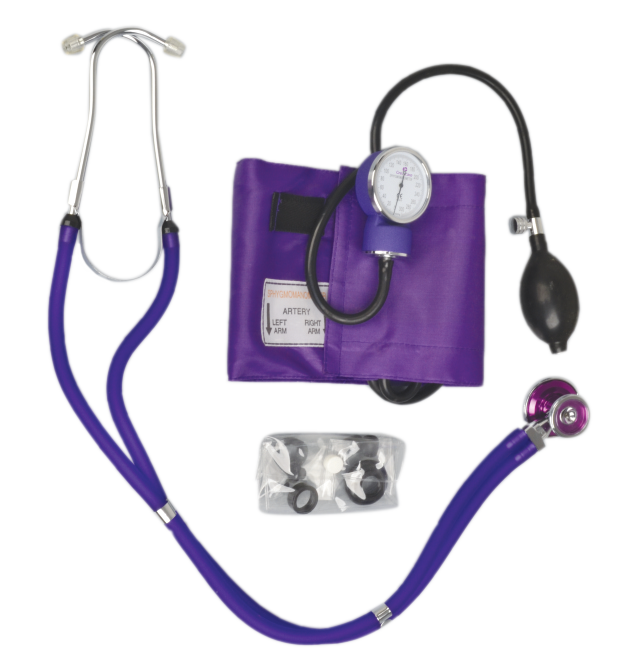

Aneroid Sphygmomanometer (with stethoscope)
Buying the right medical devices is essential for any healthcare professional, and one of the most important pieces of equipment to buy is a reliable aneroid sphygmomanometer with stethoscope. Find out in this article why these two devices are so indispensable in providing accurate readings and how they can help you ensure your patients get the best care possible.
With rappaport stethoscope.
Lavender nylon cuff, latex bulb, latex inflation system, stop-pin,w/D-ring, coloured rappaport stethoscope.
A aneroid sphygmomanometer is a device that is used to measure blood pressure. It consists of a cuff that is placed around the upper arm and a mercury or aneroid manometer. The cuff is inflated using a hand bulb and valve, and the mercury or aneroid manometer is used to measure the pressure. The aneroid sphygmomanometer is the most commonly used type of blood pressure monitor. It is simple to use and relatively inexpensive. However, it can be less accurate than other types of blood pressure monitors, such as digital monitors.
There are two types of aneroid sphygmomanometers: manual and automatic. Manual aneroid sphygmomanometers are operated by a person using a hand pump to inflate the cuff, while automatic aneroid sphygmomanometers have a built-in pump that does not require manual inflation. A stethoscope is used to listen to internal body sounds, such as the heart and lungs. It amplifies these sounds so they can be more easily heard.
There are a few reasons why an aneroid sphygmomanometer is better than a digital blood pressure meter. First, aneroid sphygmomanometers are more accurate than digital blood pressure meters. Second, aneroid sphygmomanometers are less expensive than digital blood pressure meters. Third, aneroid sphygmomanometers are easier to use than digital blood pressure meters. Finally, aneroid sphygmomanometers are more durable than digital blood pressure meters.
A stethoscope is a medical device that is used to listen to various sounds produced by the body, such as the heart and lungs. It usually consists of a long, thin tube with a small disk-shaped piece at one end that is placed against the skin. The other end of the tube is typically open so that the person wearing it can hear the sounds clearly. How does a stethoscope work? The disk-shaped piece of the stethoscope (called the diaphragm) amplifies sound waves from the body and transmits them to the earpieces. The earpieces funnel these sound waves into the ear canal, where they are then heard by the brain.
If you are looking for the best medical devices to purchase, you should consider the aneroid sphygmomanometer and stethoscope. These two devices are essential for any medical practice. The aneroid sphygmomanometer is used to measure blood pressure. It is a simple device that consists of a cuff that is placed around the arm and a mercury column that is used to measure the pressure. The stethoscope is used to listen to heart and lung sounds. It is a handheld device that has a long, flexible tube with earpieces at each end. The stethoscope is placed over the heart or lungs and the physician listens through the earpieces.
There are many pros to purchasing an aneroid sphygmomanometer and stethoscope. These devices are very accurate and allow you to measure your blood pressure and listen to your heart and lungs without having to visit a doctor or hospital. They are also relatively inexpensive, so you can save money on medical bills by using these devices at home.
There are several cons to purchasing an aneroid sphygmomanometer and stethoscope medical device. First, these devices can be expensive. Second, they may not be covered by insurance. Third, they may not be accurate. Fourth, they require batteries. Fifth, they may not work well in low light conditions. Sixth, they may be difficult to use for people with arthritis or other conditions that affect the hands.